
About UsThe Numismatic Bibliomania Society is a non-profit organization promoting numismatic literature. For more information please see our web site at coinbooks.org SubscriptionsThose wishing to become new E-Sylum subscribers (or wishing to Unsubscribe) can go to the following web page link MembershipThere is a membership application available on the web site Membership Application To join, print the application and return it with your check to the address printed on the application. Membership is only $15 to addresses in the U.S., $20 for First Class mail, and $25 elsewhere. For those without web access, write to: David M. Sundman, Secretary/TreasurerNumismatic Bibliomania
Society AsylumFor Asylum mailing address changes and other membership questions, contact David at this email address: dsundman@LittletonCoin.com SubmissionsTo submit items for publication in The E-Sylum, just Reply to this message, or write to the Editor at this address: whomren@coinlibrary.com
BUY THE BOOK BEFORE THE COINYou won't regret it! |
- WAYNE'S WORDS: THE E-SYLUM JANUARY 23, 2011
- JOSEPH R. LASSER 1923 - 2011
- NEW BOOK: SILVER DOLLARS STRUCK UNDER THE PITTMAN ACT OF 1918
- NEW BOOK: A GUIDE BOOK OF U.S. COINS, PROFESSIONAL 2ND EDITION
- BOOK REVIEW: A GUIDE BOOK OF UNITED STATES PAPER MONEY, 3RD EDITION
- DICK JOHNSON SEEKS NEW TERMS FOR NUMISMATIC ENCYCLOPEDIA
- KRAUSE PUBLICATIONS AND ELECTRONIC BOOK PUBLISHING
- DAVID LANGE ON PUBLISHING IN NUMISMATICS
- BOSTON-AREA CLUBS HOST PROGRAM WITH BENTLEY, SUNDMAN, AND BOWERS
- ROBERT J. LEUVER ON THE TENURE OF POLITICAL APPOINTEES
- MORE ON IMAGES OF ENGRAVER WILLIAM BARBER
- MORE ON SCULPTOR OSCAR NEMON AND WINSTON CHURCHILL
- 1856 ARTICLE: THE GREAT SEAL OF THE UNITED STATES
- SUGGESTIONS FOR THE NUMISMATOURIST: FINLAND AND SERBIA
- NOTES FROM E-SYLUM READERS: JANUARY 23, 2011
- HERITAGE TO HOLD SMITHSONIAN BENEFIT AUCTION
- INTERVIEW WITH COIN ARTIST AND DESIGNER DANIEL CARR
- FURTHER CONFESSIONS OF A USED-BOOK SALESMAN
- WAYNE'S NUMISMATIC DIARY: JANUARY 23, 2011
- STACK'S JANUARY 2011 NEW YORK AUCTION GLEANINGS
- PROFESSOR STUDIES ASTROLOGICAL SYMBOLS ON COIN OF ANTIOCHOS VIII
- DEAD MAN'S PENNIES STILL TURNING UP
- ELVIS NOVELTY BANKNOTE FOOLS GERMAN BANK CLERK
- FEATURED WEB PAGE: BRITANNIA ON BRITISH COINS
WAYNE'S WORDS: THE E-SYLUM JANUARY 23, 2011

Among our new subscribers this week are Richard Licato, courtesy of Howard Daniel, Thomas J. Uram, courtesy of Ed Krivoniak, Richard Alekson, courtesy of John and Nancy Wilson, and Frank Draskovic. Welcome aboard! We now have 1,395 email subscribers, plus 111 followers on Facebook, including Marc Stackler and Richard Jewell.
This week we open with sad news of the loss of another numismatic giant. In literature news, we have another new book on CD-ROM from Roger Burdette, a new edition of the Professional Red Book, and a review by Mike Marotta.
Other topics include new numismatic terminology, electronic publishing, sculptor Oscar Nemon, and the Great Seal of the United States. To learn more about an evening with Anne Bentley, Dave Sundman, and Dave Bowers, the numismatic collection of the National Bank of Serbia, Slovenian bus tokens and Dead Man's Pennies, read on. Have a great week, everyone!
Wayne Homren
Numismatic Bibliomania Society
JOSEPH R. LASSER 1923 - 2011
George Kolbe writes:
 I was saddened to learn of the death of Joseph R. Lasser. Over the years, I encountered Joe at New York coin conventions and once or twice a year, sometimes more, we would converse by telephone about various topics: "America's Foreign Coins" and their intricate history often being principal among them.
I was saddened to learn of the death of Joseph R. Lasser. Over the years, I encountered Joe at New York coin conventions and once or twice a year, sometimes more, we would converse by telephone about various topics: "America's Foreign Coins" and their intricate history often being principal among them.
Joe had a rare enthusiasm and an inquiring, indefatigable intellect. No doubt instrumental to his success in the financial world, these qualities produced an immeasurable numismatic bounty. His involvement with Colonial Williamsburg, the American Numismatic Society, and his writings only hint at the impact. More importantly, he was a warm caring family man and, in various ways, he helped a number of collectors and dealers who became, in some part, extended members of his family. Joe will be sorely missed.
"Julius was the numismatist and he was my first teacher in the field of coins... If I had been a 'satisfactory' child during the week, I was privileged to visit Julius at his home on Sunday and carry the trays of coins Julius was studying from the second floor tower and safe to Julius' first floor study. It necessarily was a slow and precise trip.
Notes would be taken; coins would be described and I, the 11-12 year old student, would be enriched by Mr. Guttag's knowledge. He was extremely strong in Latin American material and the catalogue of his collection still is a worthwhile resource."
To read the earlier E-Sylum article, see: JOE LASSER ON HIS NUMISMATIC MENTOR, JULIUS GUTTAG (www.coinbooks.org/esylum_v09n47a15.html)
I find it difficult to believe that counterfeit Lions were struck in Mexico during our colonial period. There was no specific incentive to create false coins in Mexico and it's not logical to think that someone could positively identify where a counterfeit was minted.
Mr. Hallman apparently has his story backwards. It is possible (and probable) that the Dutch Lion Dollar he found was made with Mexican silver. From about 1550 to 1750 65-70% of all the new silver that came into the world was from Spanish colonial Mexican and Peruvian (today's Bolivia) mines. As the arguably largest commercial sailing nation -- that did not have any silver mines -- it is completely logical and normal that Lion Dollars could -- and did -- reach Pennsylvania.
After all, the Dutch controlled the Colony of New York until the 1660's and some of the first paper money of New York in 1709 stated its value in Lion Dollars. Yes, there are "imitation" Lion Dollars minted in several other European countries -- primarily Italy and Germany -- although there is one from Transylvania -- that clearly illustrate the trade currency role of Lion Dollars. It was a "Bullion World" and Mr. Hallman's find is another small confirming episode.
To read the earlier E-Sylum article, see: JOE LASSER ON DUTCH LION DOLLARS IN COLONIAL AMERICA (www.coinbooks.org/esylum_v12n34a12.html)
Today the numismatic community of the old and the new world loses the kindest and most generous coin collector and numismatist. I had the privilege to have a very close and friendly relation with Joe for over 30 years. His letters and telephone calls were always so warm and encouraging.
He was a man of his word, a generous person, always interested in learning new things about numismatics and related history, an expert on Dutch and Belgian 16th century silver coins and coins of the besieged cities in the 80 Years War.
Joe was my best friend in the United States. He visited me in Brussels several times. I will miss him.
Jean Elsen Bruxelles Belgique (Belgium)
To read the complete article, see:
JOSEPH R. LASSER
(www.legacy.com/guestbook/nytimes/guestbook.aspx?
n=joseph-lasser&pid=147910006)
NEW BOOK: SILVER DOLLARS STRUCK UNDER THE PITTMAN ACT OF 1918
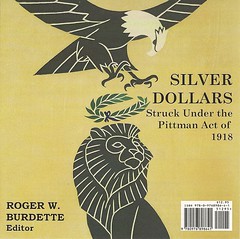 Seneca Mill Press LLC is proud to release a superb CD-ROM of unique silver dollar production records from 1921 through 1928. Silver Dollars Struck Under the Pittman Act of 1918, edited by Roger W. Burdette, includes high resolution images of the original Treasurer's journal in convenient PDF format.
Seneca Mill Press LLC is proud to release a superb CD-ROM of unique silver dollar production records from 1921 through 1928. Silver Dollars Struck Under the Pittman Act of 1918, edited by Roger W. Burdette, includes high resolution images of the original Treasurer's journal in convenient PDF format.
The Treasurer's journal presents daily production of silver dollars at all three mints in their original manuscript format. This is the only complete production record for Pittman silver dollars, yet only a handful of researchers have ever examined these important records since their re-discovery four years ago. Now collectors and silver dollars specialists can examine documents that were completely unknown to van Allen and Mallis, Breen, Taxay, Bowers and others.
This is the first and only published edition of these invaluable historic resources.
As a special bonus, the full text of the Pittman Act of 1918 is included along with a Federal Reserve Bank discussion of silver purchases since the Bland-Allison Act of 1878.
Lastly, the Silver Dollars Struck Under the Pittman Act of 1918 CD-ROM features a newly completed essay on the background of the Pittman Act and the role of Mint Director Raymond T. Baker.
This definitive edition was prepared by numismatic research specialist Roger W. Burdette. Original documents from the National Archives in College Park, MD were photographed and adapted for publication. All images are a combination of manuscript and typescript. Although not directly searchable, these image files are easy to use and print for personal use.
Silver Dollars Struck Under the Pittman Act of 1918 is available for an introductory price of $8.95 (regularly $12.95) postpaid from the publisher, Seneca Mill Press LLC. Discount orders accepted for 30 days.
To order send check or money order for $8.95 to: Seneca Mill Press LLC, PO Box 1423, Great Falls, VA 22066.
Bibliographic Entry: Burdette, Roger W., ed. Silver Dollars Struck Under the Pittman Act of 19183. Seneca Mill Press, LLC, PO Box 1423, Great Falls, VA 22066. CD-ROM, 1 disc in case. ISBN 978-0-9768986-3-4 American History; Economics; Numismatics
About the Author/Editor
Like many collectors, Roger W. Burdette began the hobby of coin collecting by attempting to fill cent and nickel albums from pocket change. During the 1970s he specialized in coin photography and produced the images for popular advertisements and hobby books. After a pause of several years, Mr. Burdette became interested in numismatic research. During more than seven years of research he has uncovered a wide array of new information including many previously unknown events.
Mr. Burdette is the author of three critically acclaimed numismatic research books: Renaissance of American Coinage 1905-1908, Renaissance of American Coinage 1916-1915 and Renaissance of American Coinage 1916-1921. Each book was awarded the prestigious NLG Book-of-the-Year Award. The trilogy covers the origin, design and initial production of our nation's most beautiful coinage. He is also the author of A Guide Book of Peace Dollars released by Whitman Publishing in November 2008.
He has written numerous articles for Coin World magazine, Coin Values magazine, Coins magazine and The Numismatist. He is a contributor to the Guide Book of United States Coins, the 8th and 9th editions of J. Hewitt Judd's United States Pattern Coins, Experimental and Trial Pieces, and the USPatterns.com website. He has also contributed to Whitman Publishing LLC books on double eagles, nickels, type coins, silver dollars, quarters and others, and contributed to David Lange's Complete Guide to Buffalo Nickels.
Mr. Burdette lives near Washington, DC with his daughters and canine editorial advisor, Ivan. He is employed by a nationally known nonprofit research and development corporation.
NEW BOOK: A GUIDE BOOK OF U.S. COINS, PROFESSIONAL 2ND EDITION
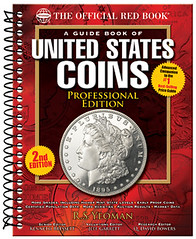 Whitman Publishing has released the second edition of its expanded version of the best-selling Guide Book of United States Coins (known within the hobby as the "Red Book"). The 384-page volume, called the Professional Edition, is intended for intermediate and advanced collectors, numismatic researchers, professional coin dealers, auctioneers, and investors. It is available online (including at WhitmanBooks.com), at bookstores nationwide, and from hobby dealers and booksellers.
Whitman Publishing has released the second edition of its expanded version of the best-selling Guide Book of United States Coins (known within the hobby as the "Red Book"). The 384-page volume, called the Professional Edition, is intended for intermediate and advanced collectors, numismatic researchers, professional coin dealers, auctioneers, and investors. It is available online (including at WhitmanBooks.com), at bookstores nationwide, and from hobby dealers and booksellers.
The Professional Edition is 45% larger than the regular-edition Red Book, at 8.5 x 11 inches, and is spiralbound for convenient reference. It retails for $29.95.
Features of the Professional Edition include:
- Detailed coverage of every federal coin type, half cents through double eagles, plus classic commemoratives, Proof and Mint sets, and bullion.
- Expert guidance on striking and sharpness characteristics for each type—valuable information when comparing coins for purchase.
- Insight on availability and condition rarity for each type.
- Detailed grading instructions, including for Mint State and Proof coins.
- Certified population summaries for every date and mintmark—including the number certified, the average grade, and the percent in Mint State.
- Expanded valuations, including multiple Mint State and Proof levels, plus Full Bands, Full Bell Lines, Cameo / Deep Cameo, and other specialized designations.
- Recent auction data for coins listed.
- Additional die varieties in every denomination, with close-up photographs for easy identification.
- Informative chart notes that expand on the history, characteristics, and market values of significant coins.
- Detailed research, estimated mintages, and market information on early 1800s–early 1900s Proof coinage, including gold.
- High-quality, full-color photographs (more than 1,600 altogether) of both circulation strikes and Proof coins, for every type.
- Enlargements of key focal points and varieties—many more than in the regular edition.
- A new section on the U.S. Mint's silver, gold, and platinum bullion coins.
- A 2009–2010 rare-coin market review, with a look forward to 2011.
The Professional Edition's editorial team consists of Senior Editor Kenneth Bressett, Research Editor Q. David Bowers, and Valuations Editor Jeff Garrett. Dozens of hobby leaders contributed their expertise to the book's production.
"The first Professional Edition came out of the gate strong and the second edition is even better," said Whitman publisher Dennis Tucker. "We've made many small but useful improvements and additions, including thumbnail photographs of every classic commemorative; dozens of new type-coin photos; and more close-ups of key details."
"Readers wanted a section on the Mint's bullion coins, so we've added in-depth coverage of that field," Tucker said. "And the rare-coin market review puts recent hobby activity in perspective."
All of the book's coin valuations, certified populations, and auction data have been reviewed and updated for the new second edition.
"The Red Book Professional Edition gives its users real-world market information on every coin ever struck by the U.S. Mint," said Whitman president Mary Counts. "As a single-source reference it has no comparison."
To read the earlier E-Sylum article, see: BOOK REVIEW: A GUIDE BOOK OF UNITED STATES COINS (PROFESSIONAL EDITION) (www.coinbooks.org/esylum_v12n52a04.html)
BOOK REVIEW: A GUIDE BOOK OF UNITED STATES PAPER MONEY, 3RD EDITION
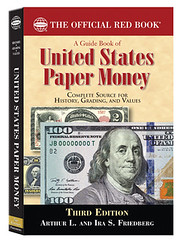 A Guide Book of United States Paper Money by Arthur L. and Ira S. Friedberg (3rd Edition; Whitman Publishing, 2011; 405 pages; $24.95) is a full-color catalog of the entire array from the first interest bearing notes to finance the War Between the States, to the most recent issues of the Federal Reserve: National Bank Notes, Treasury Notes, Legal Tender Notes, Silver Certificates, and Gold Certificates.
A Guide Book of United States Paper Money by Arthur L. and Ira S. Friedberg (3rd Edition; Whitman Publishing, 2011; 405 pages; $24.95) is a full-color catalog of the entire array from the first interest bearing notes to finance the War Between the States, to the most recent issues of the Federal Reserve: National Bank Notes, Treasury Notes, Legal Tender Notes, Silver Certificates, and Gold Certificates.
The complex iconography and lavish art of these banknotes retell the history of our nation from Columbus to De Soto, from Pocahontas to the Pilgrims, from the Battle of Lexington to the Battle of Lake Erie. Here are the farms and farmers, the factories and mechanics, steamships and steam locomotives. Miss Electricity lights up the world, rising up from America in a whirlwind of Olympian allegory. The first aeroplane is but a shadow. These paper promises are a gallery of portraits that are almost synonymous with America: Washington, Jefferson, Lincoln. But, here, too are John Marshall and John Quincy Adams, Stephen Decatur and David Farragut, Thomas Hart Benton and Henry Clay, along with a pantheon of more and less famous generals and politicians of the Gilded Age.
The material is arranged by denomination ($1 to $100,000) and then by series. Each chapter begins with a historical summary of the denomination including collecting tips for each series. And, of course, there is a table of values by grade. In each category, the authors deliver a rich array of examples. You will find national bank notes from New York, Chicago, and San Francisco, of course, but also Albuquerque, Las Vegas, Oakland, and Honolulu, as well as Jerseyville, Rondout, and Caddo.
It is an easy challenge at numismatic quiz bowls to ask when the motto "In God We Trust" first appeared on Federal paper money. I was surprised to discover how much unpaid debt from the War of 1812 is still being carried by collectors. Whether or not you actively pursue these artifacts of commerce, this book is an important and enjoyable guide to the history of America as displayed on the fiduciary instruments of our republic.
THE BOOK BAZARRE
DICK JOHNSON SEEKS NEW TERMS FOR NUMISMATIC ENCYCLOPEDIA
I am sending out my manuscript on coin and medal technology for my first peer review this month. It contains 1,851 technical terms in the field of making, describing, cataloging, collecting and curating numismatic items -- at least those that are diestruck or cast. (It does not cover paper money or similar items).
There is still ample time to include a term or two that I may have overlooked. I am appealing to E-Sylum readers to reflect on their own use of technical terms in the field, particularly those that our knowledgeable readers have originated themselves. Isn't it interesting to note that you have coined a new term in the coin and medal field?
Walter Breen in all his numismatic writing invented two new terms:
ELECTROTRIAL -- An electroformed trial piece. That is what he named those galvanos of the Buffalo Nickel by James Earle Fraser that he had Henri and Felix Weil make for him, before he was satisfied enough to have hubs made to send the U.S. Mint.
BOUNDARY -- The line between contrasting metals of the core and the clad metal in a clad coin composition.
I could not resist creating two new terms as well, because no existing term covered exactly what is meant. My two are:
MODULATED RELIEF -- The rise and fall of three-dimensional sculptural surface; the total surface planes and curvatures forming a coin or medal design.
RIM/EDGE JUNCTURE -- The point where the horizontal plane of the face of a struck piece meets the vertical plane of the edge.
That last term is useful in describing proof coinage as pressmen seek to strike a proof coin where the metal flows to and completely forms a sharp point at that intersection but not one scintilla more metal (it would cause a WIRE EDGE if it did). The architectural term "arris" is the closest I found to indicate such a point, but this didn't seem to fit coins, thus I invented my own term.
So, what technical term in the coin field have you invented? Don't send me terms on condition or those trade puffing terms about how exquisite your coin is. I want terms of factual conditions in the field.
Email me at dick.johnson@snet.net .
I will acknowledge all those I accept for inclusion and guarantee your name will be mentioned for the next 70 years -- as long as my book will be in print.
KRAUSE PUBLICATIONS AND ELECTRONIC BOOK PUBLISHING
Last week I read Scott Barman's blog post on e-books in numismatics, and was happy to see the discussion move to The E-Sylum. I'd like to add a few points to the discussion.
First, we wholeheartedly agree with Dennis Tucker's assertion that quality content is of utmost importance. We at Krause Publications feel privileged to be part of a group of publishers worldwide, large and small, who continue to serve interesting, educational, essential content to collectors from novice to expert.
Our move into electronic publishing has gone well. We began selling our Standard Catalogs on disc in 2007, and those products continue to gain market acceptance each year. Others have noted what makes CDs attractive: portability, image enlargement, the ability to print individual pages.
In 2009 we moved to "slice and dice" our content as digital downloads. This allows us to produce content that manufacturing and distribution challenges would not allow us to otherwise produce, and collectors can focus in on their niche interest.
This year you will see more and more KP books available for e-reader devices like the iPad, Kindle, Nook, etc. For instance, here are links to Kindle editions of two recent releases, Warman's U.S. Coin Collecting and Canadian Coin Digest.
Warman's U.S. Coin Collecting on Kindle Canadian Coin Digest on Kindle
Numismatic books face certain challenges in formatting for e-readers. In particular, our catalogs are image-heavy, which makes them very large files, and this can make them difficult to download. Thus, expect to see KP create e-reader specific products that are smaller and more focused than our large catalogs.
Our parent company, F+W Media, has made e-books a top priority. In fact, we are hosting the second annual Digital Book World conference in New York City starting today (January 24), and are keenly focused on staying at the front of this market revolution.
If you have any questions, comments or suggestions regarding Krause Publications' books, e- or otherwise, feel free to contact me at scott.tappa@fwmedia.com.
To read the earlier E-Sylum article, see: ()
DAVID LANGE ON PUBLISHING IN NUMISMATICS
I have thoughts on two subjects brought up in the most recent issue.
Regarding the growth of electronic publishing in numismatics, I've considered this possibility as a cost-reducing measure. I'm currently preparing a book on coin albums and folders as a follow-up to my last book on coin boards. This new book will be much larger, as it deals with a greater number of publishers and products, so the printing of hardcopies will be expensive.
I'd like to stick with my American printer, since that company did such a good job with color accuracy in the coin board book, but more and more coin book publishers are going to China for such work. I just don't know whether I can get a product that will satisfy me when dealing with the printer solely by telephone or email, and I'm not planning any trips to China to oversee the work.
The problem I have with doing a book solely in electronic format is one which many numismatic authors and publishers may have encountered---ours is a hobby that caters mostly to older people. I know that the buyers of my current book and the subscribers to my price lists and newsletters are mostly my age and older. A number of them don't have computers or email, so I still have to send out my quarterly publications by snail mail to a fair number of customers. I get orders from them in the same manner, oftentimes long after an item already sold to an email subscriber. I have a feeling that if I were to ofter my next book in both hardcopy and electronic editions, the former would be far more popular.
The situation would be different if I were writing a book about a numismatic topic that is of more interest to younger collectors. A title on American Eagle bullion coins or statehood quarters might do very well electronically, but books that appeal strongly to a nostalgia market would not be as successful. I suspect that I will go with a hardcopy print run exclusively for the next book, even though it take a few years to break even on the cost.
The other subject which caught my attention was that of "author's paralysis," the fear of publishing before one's work is perfect. I knew that additional coin board varieties would turn up subsequent to publication, and indeed they have. I've found about a dozen new varieties since the book came out, perhaps three or four major ones and the rest minor. Readers of my book have also reported new, minor varieties within their own collections.
I would love to publish a new, updated edition of my book, but I can't with so many copies of the first edition still on hand. The solution I've found is to announce new discoveries in my quarterly Coin Board News and issue a completely updated Check List and Value Guide annually to all persons on my mailing list. This is the only practical way to keep current for a subject that does not sell the thousands of books required for a second edition.
The risk of incompleteness is always present when publishing a reference in a field that was hitherto undocumented. I've tried to create numbering systems for my board and album books that will permit for additions, but certain new varieties may not fit comfortably into the existing numbering sequence, and this problem will only grow over time (just look at the ongoing debate over Sheldon's numbers for large cents in the EAC's Region 8 weekly newsletter).
After enough time has passed, I may have to revisit this numbering and make some fundamental changes, but that's still a long way down the road. I'm relieved that I was able to publish what I knew about coin boards just to get it on the record before my passing, and I'm attempting to do the same with folders and albums. The good news is that I'm fairly confident I'll be around long enough to accomplish that goal. What the hobby will do with the resulting information is anyone's guess.
To read the earlier E-Sylum article, see: WHERE ARE THE ELECTRONIC NUMISMATIC BOOKS? (www.coinbooks.org/esylum_v14n03a14.html)
BOSTON-AREA CLUBS HOST PROGRAM WITH BENTLEY, SUNDMAN, AND BOWERS
Monday, April 11
You are invited to see and hear THREE WINNERS in Waltham, Massachusetts, on April 11. A great evening program about coins, tokens, medals, and paper money featuring three well-known numismatic personalities awaits you at a special combined meeting of the New England Currency Club and the Boston Numismatic Society. The BNS, founded in 1860, is one of America's oldest institutions in the field.
The three presenters will be there to share their experiences, comment on the marketplace, perhaps predict or try to predict the future, and answer your questions. Come and be prepared to have a great time. You will meet:
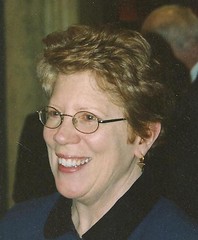
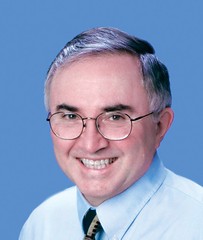
Anne Bentley: Curator at the Massachusetts Historical Society, and custodian of some of America's greatest numismatic treasures, who last summer presented a highly-acclaimed program for the ANA. She is highly acclaimend as an author, writer, researcher, and speaker. You probably know that, founded in 1791, the MHS is the oldest historical society in America.
David M. Sundman: Chief executive of Littleton Coin Co., with over 300 employees, one of America's largest rare coin dealerships. Littleton has found many "treasures" in the hands of the public—including the very first National Bank Note ever issued! He will share some of his finds with you, tell of the depth and breadth of the market, and more.
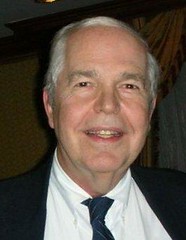 Q. David Bowers: Chairman emeritus of Stack's-Bowers Numismatics and numismatic director of Whitman Publishing, LLC, who began his dealership as a young teenager in 1953, and since that time has handled just about every rarity in the book and most of the major collections—Norweb, Eliasberg, Bass, and more. Dave is the author of over 50 books, a popular columnist, and past president of the ANA and PNG.
Q. David Bowers: Chairman emeritus of Stack's-Bowers Numismatics and numismatic director of Whitman Publishing, LLC, who began his dealership as a young teenager in 1953, and since that time has handled just about every rarity in the book and most of the major collections—Norweb, Eliasberg, Bass, and more. Dave is the author of over 50 books, a popular columnist, and past president of the ANA and PNG.
The program will be about an hour or so. Complimentary beverages and snacks await you. Wait! There's more! Whitman Publishing Company will give as door prizes some hot-off-the-press copies of the brand new 2012 edition of A Guide Book of U.S. Coins, these in addition to other great books! You may be a winner! We look forward to seeing you!
The event begins at 7:15 in the church hall of the Trinity Congregational Church, 730 Main St. (Rt 20) Waltham, Massachusetts. You are cordially invited. If you are not a member of the sponsoring clubs, please reserve space for you and your friends
ROBERT J. LEUVER ON THE TENURE OF POLITICAL APPOINTEES
The Director of the US Mint has been favored a bit more than other political positions in the Federal government, at least regarding their tenure.
I remember J. Elton Greenlee, my boss, and the Deputy Assistant Secretary for Administration, did a study on the length of tenure, or, at least, the time that political appointees spent in their appointed position. Mr. Greenlee was a career Federal employee. Our discussion took place at the time of the Ford (R) Carter (D) change of administration.
Mr. Greenlee's study found that the average tenure of political appointees was 18 months. That study included the position of Director of the Mint.
For some 50 years, and even through today, the Director of the Bureau of Engraving and Printing is a career Federal employee, who, generally, has risen through the ranks.
The fact that the BEP is the only Federal agency operating entirely on a commercial cost-accounting system and that it is a highly technical operation has saved the BEP from political appointees and the politics associated with such an appointment.
I became Assistant Director for finance and administration in 1979, during the Carter administration. That did cause some political anxiety when the Director's position became vacant in December 1982. On January 1, 1983, I was appointed Acting Director and confirmed in that position on February 22, 1993, by Secretary Donald Regan, when the White House failed to act.
Of course, you are aware of the Plum book, denoted by the color of its cover. The Plum book is published by the Government Printing Office every four years, and includes all the positions in the Federal government subject to a political appointment. I shuddered when I noted that the Plum book edition published at the end of President Reagan's first term listed my own job, the Director of the Bureau of Engraving and Printing.
To read the earlier E-Sylum article, see: MORE ON THE TENURE OF U.S. MINT DIRECTORS (www.coinbooks.org/esylum_v14n03a13.html)
THE FIRST BLOCKBUSTER OF THE NEW YEAR!
MORE ON IMAGES OF ENGRAVER WILLIAM BARBER
Readers of The E-Sylum are a sharp-eyed bunch. Charles Riley of the U.K. writes:
I had a look at the photo of William Barber in my copy of Julian's "Medals of the U.S. Mint" following the article and photograph in the last
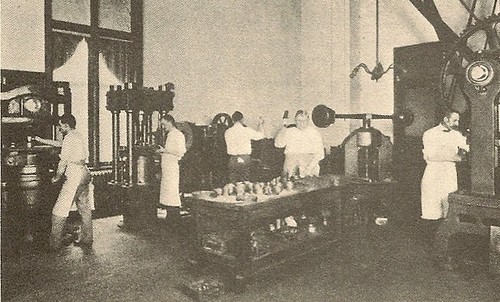
I found a link on Google Images to the ANACS site. It features the same photo but reversed 180 degrees. Their attribution for the photo is as follows:
A large screw press may be seen in this detail of a plate from
The United States Mint at Philadelphia by James Rankin Young
If this is true then the heavyset man could not be William Barber since he died in 1879.
Roger Burdette writes:
I've never seen a photo of William Barber - dead or alive. As he kicked the bucket in September 1879, I doubt he'd be in a 1903 photo.
There is a U. S. Mint medal of William Barber on page 192 of Julian's book (Julian MT-19).
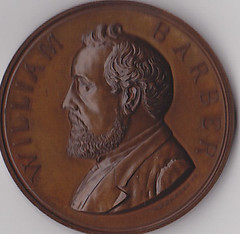
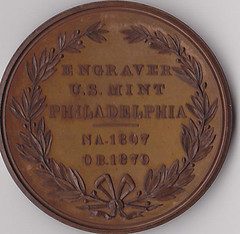
To read the complete article, see: QUERY: IMAGES OF ENGRAVER WILLIAM BARBER SOUGHT (www.coinbooks.org/esylum_v14n03a11.html)
MORE ON SCULPTOR OSCAR NEMON AND WINSTON CHURCHILL
Regarding Dick Johnson's earlier mention of sculptor Oscar Nemon, Jim Duncan of New Zealand writes:
I had hoped the 'preferred' bust of Churchill by Nemon might have been illustrated.
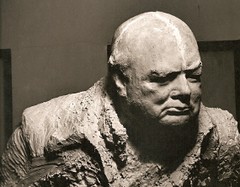 Nemon wrote in 1953 that he considered Churchill "one of the most remarkable personalities of all time", having admired him throughout the war. The two men first met at the La Mamounia Hotel in Marrakech early in 1951. Born in Yugoslavia, Nemon had lived in Britain since the 1930's, but had lost almost all his family to the Holocaust, leading him to view Churchill with the depth of feeling which brings his portraits of the statesman so intensely to life.
Nemon wrote in 1953 that he considered Churchill "one of the most remarkable personalities of all time", having admired him throughout the war. The two men first met at the La Mamounia Hotel in Marrakech early in 1951. Born in Yugoslavia, Nemon had lived in Britain since the 1930's, but had lost almost all his family to the Holocaust, leading him to view Churchill with the depth of feeling which brings his portraits of the statesman so intensely to life.
Lady Churchill asked Nemon if she could keep the terracotta bust he made at La Mamounia because it "represents to me my husband as I see him and as I think of him." Shaped in Nemon's hotel room, it began a creative collaboration between the two men which made Nemon Churchill's choice of sculptor when Elizabeth II commissioned a bust of Sir Winston for Windsor Castle in 1952.
To read the complete article, see: Nemon and Churchill (oscarnemon.org.uk/history/churchill_hist.html)

1969, Great Britain/U.S.A. 25TH ANNIVERSARY OF D-DAY. By Oscar Nemon for Medallic Art Company, New York. AE 64mm. Obv: Head of Churchill, right. Rev: An armorial shield. Engstrom 87B
To read the complete item description, see: 1969, Great Britain/U.S.A. 25TH ANNIVERSARY OF D-DAY. Engstrom 87B (prostores2.megawebservers.com/hedleybetts_com/Detail.bok?no=1744)
1856 ARTICLE: THE GREAT SEAL OF THE UNITED STATES
Anne E. Bentley of the Massachusetts Historical Society writes:
As is often the case, while researching one thing I stumbled upon this illustrated article in Harper's New Weekly Magazine (vol. 13, 1856, author unidentified) which might be of interest to your readers.
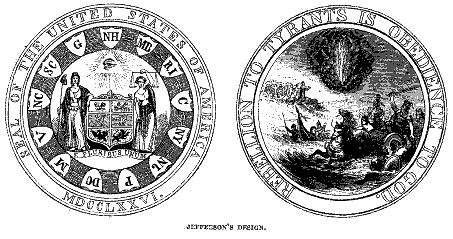
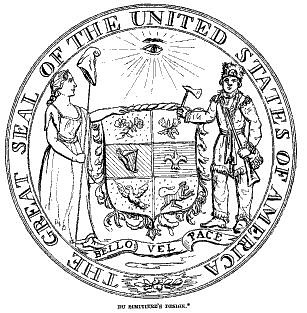
To read the complete article, see:
THE GREAT SEAL OF THE UNITED STATES
(http://dlxs2.library.cornell.edu/cgi/t/text/pageviewer-
idx?c=harp;cc=harp;q1=great%20seal;rgn=full%20text;
view=image;seq=0188;idno=harp0013-2;node=harp0013-2%3A3)
SUGGESTIONS FOR THE NUMISMATOURIST: FINLAND AND SERBIA
Howard A. Daniel III writes:
Howard Berlin has assisted me in the past when he visited the Berlin Mint. My next destination for him is the Mint of Finland. This mint produced the current circulating coins for Viet Nam, and some of their non-circulating legal tender. The lowest circulating denomination is 200 Dong but one of their annual reports shows a 50 Dong coin in it! When these coins were first contemplated and designed, the 50 Dong could have circulated, and the 100 Dong too. If patterns, proofs, trials, essays or whatever they call them were made of the entire 2003 series, I would love to have their images, weights and measurements.
This mint has not responded to my enquires, just like the Berlin Mint before Howard found the right contact for me. If he can do the same magic for me at the Mint of Finland, I would consider buying him a box of gold coins; chocolate covered gold foil, of course, with the JFK Half Dollar design. I know it is not on his schedule, but who does not want to travel to Finland for a few days?
Ralf Böpple of Stuttgart, Germany writes:
The National Bank of Serbia in Belgrade has both a coin collection and exhibits. As to my knowledge they have only restricted visiting capacities, I have contacted somebody at the bank, and they have forwarded me the information below.
To read the earlier E-Sylum article, see: QUERY: NUMISMATOURIST HOWARD BERLIN SEEKS TRAVEL DESTINATIONS (www.coinbooks.org/esylum_v14n03a12.html)
NOTES FROM E-SYLUM READERS: JANUARY 23, 2011
Dennis Tucker of Whitman Publishing writes:
As fragile as the broader publishing world seems these days (witness the dramatic bankruptcy and restructuring news from Borders and Barnes & Noble this past week), coin and paper-money collectors will enjoy a cornucopia of great new books from Whitman this year. My fingers are cramped from typing press releases!
The new Bowers gold dollar book, Rick Tomaska's opus on Franklin and Kennedy halves, a new edition of Friedberg's Guide Book of United States Paper Money, Robert Azpiazu's amazing reference on Federal Reserve Notes (which is already burning up our web site, and which I believe will be the equivalent of the next "Cherrypickers' Guide"), a soon-to-be-released "100 Greatest" book on modern coins (by Scott Schechter and Jeff Garrett), the 65th edition of the classic Red Book, The Secret History of the First U.S. Mint (Augsburger and Orosz), plus some landmark new works scheduled for this summer and fall..... it's a bumper crop.
Never mind the foibles of the rare-coin market; if you're a numismatic bibliomaniac, the BOOK MARKET is looking up all year.
Skip Lane writes:
In response to last week's article, JOHN SINNOCK AND THE PURPLE HEART, I believe there is one relevant fact that was omitted. While it was officially revived on Feb. 22, 1932, it could be awarded retroactively to April 5, 1917, the day before the United States entered World War I to any veteran who had been awarded the Meritorious Service Citation Certificate, Army Wound Ribbon, or were authorized to wear Wound Chevrons.
My grandfather had a purple heart as well as other medals awarded to him for his military service which ended soon after WWI. I have a few fragments of his service record (as well as the medals) and it is mentioned that he was entitled to wear the Wound Chevron and the Citation Star. I initially assumed thought that Wound Chevron and Citation Star were the official names of the Purple Heart and Silver Star Medals, both of which he had. It was only much more recently that I learned that the Purple Heart and Silver Star were not authorized until 1932, long after his service ended, but that they were retroactive.
I asked my mom recently if she knew anything about this (my grandfather long since deceased) and all she knows is that when she was a girl she remembers the father going to Hartford, I believe, and getting a couple of medals. I assume these were the Purple Heart and Silver Star.
To read the earlier E-Sylum article, see: JOHN SINNOCK AND THE PURPLE HEART (www.coinbooks.org/esylum_v14n03a20.html)
THE BOOK BAZARRE
HERITAGE TO HOLD SMITHSONIAN BENEFIT AUCTION
At a Jan. 6 reception at the Florida United Numismatists Coin Show in Tampa, Fla., Heritage Auction Galleries President Greg Rohan announced the firm's intention to conduct a 2012 FUN auction session in Orlando, Fla., with the goal of raising $1 million in "donated consignments" to create an endowment for the Smithsonian's National Numismatic Collection.
The initiative was kicked off by a private collector, who has already donated an 1895 Morgan dollar in Proof-66 Deep Cameo to the effort. The coin is valued at more than $100,000.
The National Numismatic Collection, housed at the Smithsonian's National Museum of American History in Washington, D.C., contains more than 450,000 coins, medals and tokens and 1.1 million pieces of paper money. Among the rarities are a Brasher half doubloon, the unique 1849 double eagle, two 1877 $50 gold patterns, a 1913 Liberty Head nickel, three 1804 Draped Bust silver dollars and two 1933 double eagles.
"We as collectors and dealers both, who are at the forefront of the numismatic world, are charged with a responsibility to grow our hobby," Rohan said.
The National Numismatic Collection is often the first taste of coin collecting that elementary and high school students have, he said.
One-third of the Smithsonian's operating budget comes from donations, but very little of that is dedicated to the National Numismatic Collection, Rohan said.
The endowment is expected to allow the Smithsonian to begin an online catalog of the entire collection, build a web reference library, and back traveling exhibits.
To read the complete article, see: Heritage to Hold Smithsonian Benefit (www.numismaster.com/ta/numis/Article.jsp?ArticleId=17220)
INTERVIEW WITH COIN ARTIST AND DESIGNER DANIEL CARR
You have a very unique profession, minting your own tokens and medallions. How did you get into this profession?
Daniel Carr: I've always been interested in coins, since I was 14 or so. I achieved a B.S. degree in Mechanical Engineering, and I liked doing art work as a hobby. Put the three together and you get minting.
You design and mint numerous different coins and fantasy pieces. Where does the inspiration for the designs come from?
DC: I think like a coin collector. Inspiration comes from what I think would be interesting as a collector. I make things that I want. So I usually end up keeping one or more of each item I make to add to my own collection.
You helped spark rumors of a new currency with your "Amero" coins. The coins ignited a lot of controversy and maybe even some concern. Before you conceived the "Amero" coin, did you ever think they would ignite so much controversy?
DC: No, the reaction was way beyond what I expected. I hadn't anticipated that a certain radio talk show host would make such a big deal about the official Amero proposals and my coins. His statements were often false and inflammatory. The resulting unintentional publicity was good for coin sales, however. My intent with the coins was to make an interesting conversation piece that would get people to think about the potential future.
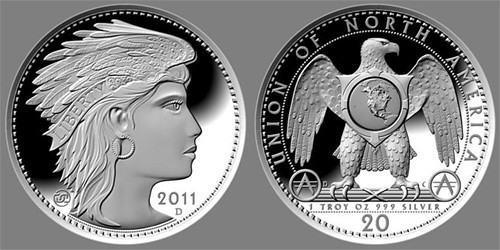
Feathered Liberty Head 20 Ameros
Out of all of your designs, which would you say is your favorite?
DC: At the moment, three come to mind (in chronological order):
- 2006 Nikola Tesla Sesquicentennial medal;
- 2009 Prosperity Tree / Weed Money Hard Times Token;
- 2010 Feathered Liberty Head 20-Ameros.
But, in general, my favorite is often the next one I'm working on, whatever that might be.
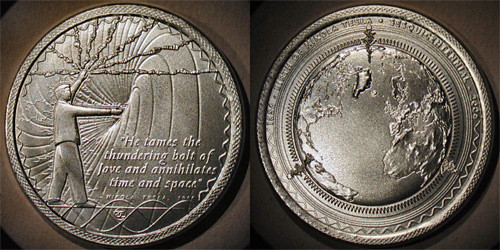
2006 Nikola Tesla Sesquicentennial Medal
To read the complete article, see:
Interview with Coin Artist and Designer Daniel Carr
(news.coinupdate.com/interview-with-coin-artist-and-
designer-daniel-carr-0636/)
FURTHER CONFESSIONS OF A USED-BOOK SALESMAN
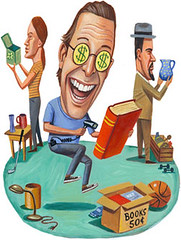 Despite the previous post, some things haven't changed much in the book industry. Chief among these is the never-ending exchange of books between local shops and scouts (or runners as they're called in the UK). We're not talking Kelmscott Chaucers here, we're talking solid, reliable trade paperback fiction and nonfiction. The stuff of everyday book trade. You see, many of the used books picked up on a Sunday afternoon jaunt to the local used bookstore did not come from members of the book-reading public like yourselves. Rather they are schlepped all over town by bus, granny cart or beater, passed across the buy counter by the nearly invisible network of scouts operating in any given region. The most successful of these scouts (i.e., the ones who pay most of their bills on time) share common traits, and it's worthwhile to take a look at a few of them.
Despite the previous post, some things haven't changed much in the book industry. Chief among these is the never-ending exchange of books between local shops and scouts (or runners as they're called in the UK). We're not talking Kelmscott Chaucers here, we're talking solid, reliable trade paperback fiction and nonfiction. The stuff of everyday book trade. You see, many of the used books picked up on a Sunday afternoon jaunt to the local used bookstore did not come from members of the book-reading public like yourselves. Rather they are schlepped all over town by bus, granny cart or beater, passed across the buy counter by the nearly invisible network of scouts operating in any given region. The most successful of these scouts (i.e., the ones who pay most of their bills on time) share common traits, and it's worthwhile to take a look at a few of them.
The good scout knows authors, titles and publishers. S/he knows what books sell and what don't. They have quick hands and minds, and even better luck. They know the local shops, their specialties and weaknesses, even the strengths and ignorance of individual buyers at specific shops. They know every thrift store in a fifty mile radius, which ones are hot and when, and they just happen to be there when the fresh donations are put out for sale. They're able to turn up good, valuable books in the most unlikely of places, pulling hundreds of dollars worth of books out of trash heaps, storage lockers and boxes of abandoned household wares left on the street after a move. They just know where to find good titles, you know? Always on the trail of a valuable book, probably most important to the successful scout is that they never stop working their typically hand-to-mouth existence.
To read the complete article, see:
The Modern Bookscout, Part 2: Local Scouts, Local Booksellers
(hitliterature.com/content/modern-bookscout-part-2
-local-scouts-local-booksellers)
The modern bookscout has a number of tools at his/her disposal, with the essential armament in the arsenal being the brain, shortly followed by the handheld scanner, which come in a variety of shapes, sizes and prices. From the hideously cumbersome to the nearly invisible and wireless, there is no guaranteed method for successful usage, but one encounters all kinds of tactics out in the wild.
I know one suspicious-eyed 50-something chap who entirely forgoes the handheld device in lieu of (likely as a means of saving money) toting around a battered and somewhat crippled Apple Powerbook, forlornly hoping for a wireless signal. I also know more than a few "secret scouts" who keep their scanners hidden until the last minute, on the low down so to speak, thinking nobody will know what they're up to if only they keep that little toy in their pants, as if it were a crime or something only they know about. Fact is that TONS of people know about scanning, but not everyone is into it.
I personally use a hybrid method as do most of the other successful dealers I know, but the fact remains that there is a lot of competition and one has to know books (in general) and bookselling (in general) in order to survive. Moreover, one has to be pretty tough and hard nosed to hang with the best, as the good scouts and dealers move fast and can be really, really aggressive. I know because I'm one of them, but at the same time, I stay courteous and polite. There are a lot of books out there, and sometimes taking one's time and having a method can prove quite valuable indeed.
Many dealers simply eschew any sort of high-tech information, to which I say they are foolish, usually because they'll take their little treasures back to the office (more often some kind of storage shed or dingy apartment) and look them all up anyway. "I have everything I need up here," pointing to their crusty old noggins, but really, that's just a foolish way of looking at modern-day bookselling. Sure, go ahead and just buy whatever suits your fancy or previous experience, but the fact remains that this sort of dealer will make a comparatively huge number of mistakes. And that's really the key to using a scanner--it doesn't magically "find" the good books, it is simply a tool, an informational tool that keeps one from making costly errors.
To read the complete article, see: The Modern Bookscout, Part 3: Isn't Technology Grand? (hitliterature.com/content/modern-bookscout-part-3-isnt-technology-grand)
To read the earlier E-Sylum article, see: CONFESSIONS OF A USED-BOOK SALESMAN (www.coinbooks.org/esylum_v13n41a26.html)
WAYNE'S NUMISMATIC DIARY: JANUARY 23, 2011
You may recall that last week we were deciding on whether to postpone the January meeting of my Northern Virginia numismatic social club, Nummis Nova. In the end we did postpone it for a week, and that turned out to be a good idea. The weather got bad late in the afternoon and when I arrived home from work my own street was already very icy.
When this Tuesday morning rolled around it was deja vu over again. When I woke up everything was caked in ice. But I didn't let it bug me. I went out and tossed salt around our driveway and sidewalk, then started my car and turned on the heater and defrosters. Then I went back inside to have some breakfast. When I came back out I turned off the car and pretty easily scraped the ice off. The driveway took more time, but the ice shattered into little pieces when I worked on it with a long-handled scraper. I showered and got ready for work. Luckily there was no more precipitation, and the main roads were fine.
So our Tuesday evening dinner was on. After work I headed to the Tyson's Galleria Mall, where our meeting was being held at the Wildfire restaurant. Dave Schenkman and Gene Brandenburg were already seated at our table. Bill Eckberg arrived next, passing around an 1804 spiked chin half cent.
Unfortunately, the coin had a problem - someone had turned the coin into an 1801, a date never struck by the U.S. Mint. Had the coin not been altered, it would have been the second finest known of the variety. How sad! Later someone joked that "somebody ought to turn the 1 back into a 4..."
Mike Packard had a newer product of the U.S. Mint to display - a new 2011-D Native America Wampanoag Treaty dollar. Someone asked where the date was (it's on the edge), and someone else piped in that "it's a Forever Dollar" like the Postal Service's "Forever Stamp".
When Roger Burdette walked in he handed me a copy of his new CD-ROM book, Silver Dollars Struck Under the Pittman Act of 1918. See the press release elsewhere in this issue.
I passed around a 1936 bronze Carnegie Hero medal. I'd purchased it on eBay a couple months earlier. Dave Schenkman noted that there were a few of these coming up in the Stack's Americana sale (see a later item in this issue for a silver Carnegie Hero medal from that sale).
As a theme for the meeting, I jokingly had suggested "die varieties of Lithuanian subway tokens", and Jon Radel showed up with a group of eight Slovenian bus tokens in different colors, each in a holder with a (fake) Krause-Mishler number. You don't see THAT every day.
Bill Eckberg also had a chocolate coin story to report. One time for the Early American Coppers convention, he had a number of chocolate coins made, using real coins as the model. One was a particularly rare half cent die variety. They offered a free EAC membership to anyone who could find and properly attribute the variety. One gentlemen did - he was a newbie to the group, and later became very active.
Two people had questions for E-Sylum readers. Here they are:
- When will the Whitman Half Cent/Large Cent book be published? (It's been in the works for a while)
- Can anyone recommend any decent coin apps for the iPhone or Android?
Howard Daniel, Chris Neuzil, Wayne Herndon and Tom Kays attended as well, although I didn't get to talk much with their end of the table. I was feeling sore and hadn't eaten much of my dinner. I had been coughing all day, and was fading fast. I said my goodbyes and left as soon as our checks arrived. I bought some generic Nyquil on the way home and it worked wonders - I felt fine the next morning.
Not much else to report numisamtically except that numismatic books and catalogs kept arriving all week. One shipment was a box of old books I'd bought for resale, and others were mostly review copies of new books. My review pile is getting ominous.
I did notice a new dollar bill in my wallet on Thursday - it was the first Series 2009 I recall seeing, with the signature of Treasury Secretary Tim Geithner and Treasurer Rosa Rios. Little did I know that their names would come across my radar again soon.
Sunday afternoon I finally got around to reading Monday's Coin World and saw an article that said the U.S. Mint would not strike medals for Geithner and former Mint Director Ed Moy, "bringing a halt to two traditional, longtime series of Mint-produced medals." That's a real shame. The first Mint Director honored with a medal was H.R. Linderman. The Treasury Secretary's medal began in 1890.
Another article answered my next question - who the heck is in charge of the Mint now that both Moy and his Deputy Director Andrew Brunhart have left? Until the President appoints a new Director, the Treasurer of the U.S. Rosa Gumataotao Rios "will carry out the duties and powers prescribed by the secretary of the Treasury to direct the program and operations of the United States Mint." (Both articles are on page 10 of the January 31, 2011 issue).
That's all for this week. Happy collecting, everyone!
STACK'S JANUARY 2011 NEW YORK AUCTION GLEANINGS
Reading through copies of the catalogs for the two Stack's auction sales coming up in New York this week, I found a number of interesting items that caught my eye. Here are a few. The paper item is from the January 25 "52 Collection", and the medal and token are from the January 26-27 Americana sale.
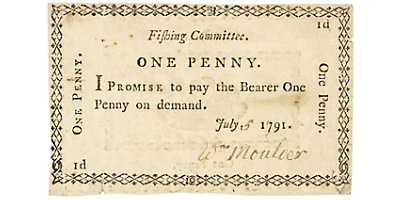
Lot 3464: Wm. Moulder, "I promise to pay Bearer," [for the] Fishing Committee [Philadelphia, Pennsylvania]. One Penny. July 1791. Issued Note. The Newman Plate Note. Rarity-7. Considered unique, the only example observed. James DuPont sent copies of his change bills to Mr. Newman for use in his book. An extremely charming note which any knowledgeable collector recognizes as a major rarity at first glance. The inclusion of the note in this collection is due to the nature of colonial era "fishing" companies and organizations.
To read the complete lot description, see: Wm. Moulder, "I promise to pay Bearer," [for the] Fishing Committee (www.stacks.com/Lot/ItemDetail/187717)
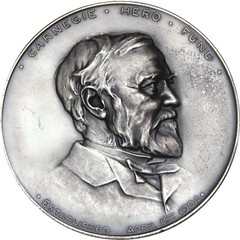
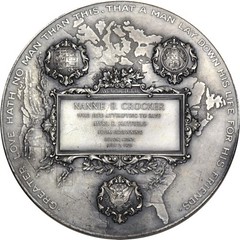
Lot 6451. 1920 Carnegie Hero Fund Silver Medal to Nannie E. Crocker. Silver, 76.2mm, 226.2 grams. With book-type case of issue. Choice Uncirculated. Obv. Andrew Carnegie bust r., ESTABLISHED APRIL 15th 1904 below. Rev. Relief map of North America with Arms of Canada (4 provinces only), Newfoundland (then a separate Crown Colony) and the U.S. Biblical quote GREATER LOVE HATH DO MAN THAN THIS, THAT A MANY LAY DOWN HIS LIFE FOR HIS FRIEND. Insert die at center recalls award to NANNIE B. CROCKER/ WHO DIED ATTEMPTING TO SAVE/ MYRL E. HATFIELD/ FROM DROWNING/ DILLON, MONT./ JULY 2, 1920. Edge incuse PAT. DEC. 11. '06 SILVER J.E. CALDWELL & CO. PHILA. Virtually as issued, trace of deepening of the antiquing at obverse r. Housed in original 116 x 113mm leather book-type case with green plush interior, CARNEGIE/ MEDAL on cover.
To read the complete lot description, see: 1920 Carnegie Hero Fund Silver Medal (www.stacks.com/Lot/ItemDetail/191099)
Beginning at lot 6587 is "a landmark collection of tokens and medals of John Adams Bolen formed by Q. David Bowers."
We present a landmark collection of tokens and medals issued by famous diesinker John Adams Bolen, who from the 1860s onward issued many interesting, beautiful, and rare pieces, nearly all in limited quantities. Bolen, himself a numismatist, issued most of these as delicacies for the numismatic trade, with information and publicity given concerning them as they were released.
Certain of the dies passed to others, as described below, and in the same era, continuing to, perhaps, through the 1870s, additional examples were struck, less documented than the ones from Bolen's shop. These tokens have been the subject of many articles and studies in various publications over the years, as well as listing for many in Russ Rulau's Standard Catalog of U.S. Tokens 1700-1900, by Krause Publications. Beyond that, in recent years there has been a movement to list Bolen pieces struck in the early 1860s as Civil War tokens.
The pedigrees for Dave's tokens include, foremost, the cabinet of Donald M. Miller, the late numismatist of Indiana, Pennsylvania, who during the 1950s and 1960s was very prominent in the field of store cards and tokens, including Hard Times tokens (perhaps forming the greatest collection ever), Bolen tokens (ditto), and store cards dating from before the Civil War (again, probably the finest).
The Miller collection of Bolen tokens went to Charles Litman, the late dealer who for many years was a prominent professional in downtown Pittsburgh. Dave purchased many if not most of the Miller pieces from Charles and, later, his widow. Others were from the collection of Andrew Zabriskie, famous 19th century numismatist, whose collection was sold a few years ago by Sotheby's, with David Tripp representing Dave Bowers at the sale.
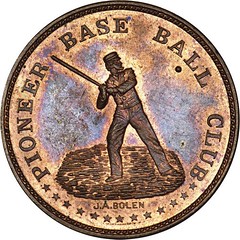
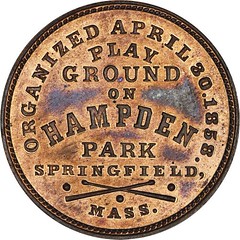
Lot 6587: (1861) Pioneer Baseball Club token. Copper, 31.5mm, 13.1 grams. Musante JAB-1. Mint State. Obv. Baseball player at bat, at center, PIONEER BASE BALL CLUB around. Rev. PLAY GROUND ON HAMPDEN PARK, at center, date of organization around, bats and balls below. Nearly Choice with inviting prooflike reflectivity on both sides, accentuating the predominantly red copper surfaces. Areas of soft violet and blue are seen in the fields. Slightly double struck on the reverse. One of 75 examples reported struck by Bolen in this composition and always in demand as this is likely the first token dedicated to Baseball ever struck.
To read the complete lot description, see: (1861) Pioneer Baseball Club token. (www.stacks.com/Lot/ItemDetail/191219)
PROFESSOR STUDIES ASTROLOGICAL SYMBOLS ON COIN OF ANTIOCHOS VIII
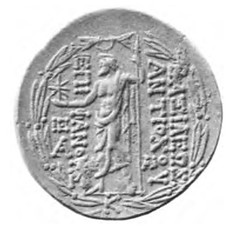 An unusual Greek coin, minted around 120 BC, may have marked a moment in time when people in ancient Syria saw Jupiter being blocked out by the moon.
An unusual Greek coin, minted around 120 BC, may have marked a moment in time when people in ancient Syria saw Jupiter being blocked out by the moon.
On one side is a portrait of Antiochos VIII, the king who minted it. On the reverse is a depiction of Zeus, either nude or half-draped, holding a sceptre in his left hand. Above the god's head is the crescent of the moon, and his right arm is outreached with a star like figure (that may in fact be Jupiter) hovering just above his palm.
"Nobody ever re-used this iconography again – it was a one off," said Professor Robert Weir, of the University of Windsor in Canada, who presented his research recently at the annual meeting of the Archaeological Institute of America.
Weir is a Classics professor with an interest in astronomy and ancient coins. He was curious why Antiochos VIII would mint a piece of currency with such an unusual drawing – could there have been something going on in the night sky?
"I did some calculations to see what was visible from Antioch, the capital of the Seleucid Empire – I came up with some interesting patterns." Weir found that on January 17, 121 BC, the city's residents would have seen Jupiter blocked out by the moon, an event modern day astronomers call an "occultation."
To read the complete article, see:
2,100 year-old Greek coin may have marked rare astronomical event
(www.unreportedheritagenews.com/2011/01/
2100-year-old-greek-coin-may-have.html)
DEAD MAN'S PENNIES STILL TURNING UP
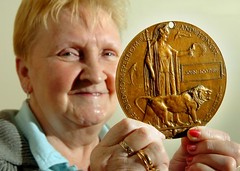 The British Government honored their war dead after World War I with a large uniface cast medallion given to family members with the name of their fallen relative worked into the design. This along with Britannia holding a wreath and trident with the British lion at her feet on the face of this 4 3/4-inch cast bronze memento.
The British Government honored their war dead after World War I with a large uniface cast medallion given to family members with the name of their fallen relative worked into the design. This along with Britannia holding a wreath and trident with the British lion at her feet on the face of this 4 3/4-inch cast bronze memento.
Unfortunately, the medal has earned the ungracious name "Dead Man's Penny" in Britain over the years. I refused to call it that when I was in the medal business, instead calling it a "War Dead Memorial Medallion" as I sold perhaps a dozen or so of them.
They are not rare -- 908,371 service personnel, both men and women died in the Great War -- that many could have been issued. Now three or four generations later they are turning up in family possessions, often with the question, "Just what are these things?"
That happened last week in Walton-le-Dale, England where a lady there came by her grandfather's memorial medallion. Some family member years ago must have drilled a hole near the top to mount it on a wall. As a collectable, the hole drops the maybe $40 value in half, but it was family property, they could do what they wished.
This is not the last word. They will continue emerging long into the future.
To read the complete article, see:
The coin that completes relative's heroic legacy
(www.lep.co.uk/lifestyle/the_coin_that_completes_relative
_s_heroic_legacy_1_2943916)
To read the earlier E-Sylum article, see: THE DEAD MAN'S PENNY (www.coinbooks.org/esylum_v09n46a16.html)
ELVIS NOVELTY BANKNOTE FOOLS GERMAN BANK CLERK
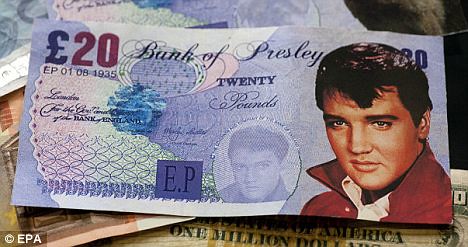
Contrary to what many people might believe, bank notes with Elvis Presley on them are not legal tender.
So when one ended up in the banking system in Germany the German Central Bank was not best pleased.
This is the £20 Elvis banknote which a counter clerk in a German bank failed to spot when a customer paid money into their account with a pile of multi-denominational notes.
The illegal tender was one of a number of personalised Elvis novelty notes that are for sale as souvenirs on the Internet to fans of The King.
The German Central Bank displayed it and several others in Frankfurt this week as specimens of the 60,000 fakes which managed to get into the country's monetary system last year.
'Obviously it is a fraud but it entered the banking system so someone got some real money for it,' said a bank spokesman, who was clearly all shook up.
Elvis banknotes can be found for sale on Ebay for £1.49
-novelty-banknote-fools-teller-German-Central-Bank.html)
FEATURED WEB PAGE: BRITANNIA ON BRITISH COINS
This week's Featured Web Page is a history of the image of Britannia on British Coins.
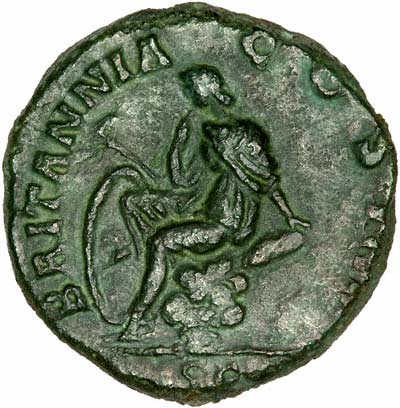
Britain was known to the Romans as Britain or Britannia well before the brief visit by Julius Caesar in 55 BC. They regarded it as the "end of the world". Julius Caesar made a second visit to Britain the next year. Neither of these visits, both of which were restricted to Kent, had any great or lasting effect on the inhabitants.
www.24carat.co.uk/frame.php?url=britannia.html
